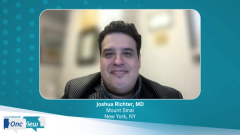
Overview of Multiple Myeloma and Treatment Options
Joshua Richter, MD, gives an overview of treatment options in multiple myeloma and factors that influence treatment decisions.
Episodes in this series

Transcript:
Joshua Richter, MD: Hello, my name is Dr Joshua Richter. I’m an associate professor of medicine at the Tisch Cancer Institute Icahn School of Medicine at Mount Sinai, and the director of myeloma at the Blavatnik Family Chelsea Medical Center at Mount Sinai. I’d like to welcome you to this CancerNetwork® event entitled “Using Selinexor in Patients With Relapsed and Refractory Multiple Myeloma.”
When we think about patients with myeloma, we group them into 2 categories: newly diagnosed, and relapsed and refractory multiple myeloma. In the newly diagnosed setting, we have a variety of different treatment options, many of which in the United States all revolve around a base of VRd, Velcade [bortezomib], Revlimid [lenalidomide], and dexamethasone. Although there are a variety of options within there, including substituting Kyprolis [carfilzomib] for bortezomib, or cyclophosphamide for lenalidomide.
But once patients go beyond their front line, they enter into the realm of relapsed and refractory multiple myeloma, and we seek a variety of different options. Initially, in the early phases of therapy in the relapsed setting, we use different classes of agents, such as the IMiDs, immunomodulatory drugs, like lenalidomide and pomalidomide; or proteasome inhibitors, like bortezomib and carfilzomib; or CD38 antibodies, like daratumumab and isatuximab. Once we get beyond the initial lines of therapy, we look to other mechanisms of action, including selective inhibitors of nuclear export, like selinexor, as well as some of our BCMA-targeted therapies, like bispecific antibodies and CAR [chimeric antigen receptor] T-cell therapy.
In multiple myeloma, there’s no clear optimal path for every single patient. We must figure out a variety of factors to choose which therapy or combination of therapies are going to be the best. In general multiple myeloma, we use 3 factors to determine this: patient-related factors, disease-related factors, and treatment-related factors. Patient-related factors include age, frailty, and comorbidities. We look at disease-related factors. How aggressive is the disease? Is it relapsing quickly or slowly? Is there extramedullary disease? Is there CNS [central nervous system] involvement? Are there high-risk cytogenetics? And for treatment-related factors, what therapies has the patient had before? What therapies are they refractory to? Which ones did they respond well to, or not well to? With which therapies do they have ongoing residual toxicities? For example, if we think about a patient who receives an IMiD, a drug like lenalidomide, and progresses rather quickly, my next line of therapy is not likely going to rely solely on pomalidomide, another drug within that class. I’m going to look to switch classes to get a better response to therapy.
Transcript edited for clarity.
Newsletter
Stay up to date on recent advances in the multidisciplinary approach to cancer.



















































































